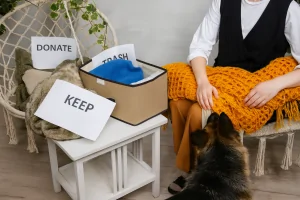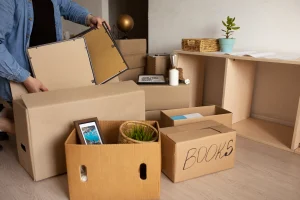Every move marks a new beginning. But before you unpack in your new home, there’s one essential step that can completely transform your experience: decluttering before moving.
Sorting what to keep, donate, or toss isn’t just about tidying up — it’s a real strategy to save time, money, and energy. The less you move, the easier, cheaper, and more efficient the entire process becomes.
Each eliminated box means less to pack, less to carry, and less to unpack. Plus, it gives you the freedom to start your new chapter in a clean, organized, and functional space.
Decluttering for a move isn’t a side task — it’s the foundation of a smart relocation. By letting go of what you no longer need, you gain clarity, order, and control over the process.
In the next sections, you’ll discover how to decide what’s worth keeping, what can be donated, and what should be discarded — step by step, with practical examples and expert tips from Moishe’s Moving & Storage professionals.
Because every easy move begins with a well-made selection.
1. Why Decluttering Before Moving Helps You Save Time and Money
A successful move doesn’t start with packing — it starts with sorting your belongings. The process of decluttering before moving is one of the most effective ways to reduce costs, wasted time, and the stress that comes with any relocation.
In long-distance moves, moving companies charge based on weight and volume. The less you move, the lower the costs. Getting rid of unnecessary items automatically means fewer boxes to pack, fewer hours to pay for, and a lower risk of damage during transport.
The time saved is just as valuable. Less to pack means less to label, less to unload, and less to organize at your destination. Instead of spending hours unpacking things you no longer use, you can immediately start setting up your new space.
Beyond the practical benefits, decluttering for a move also brings an emotional advantage — a sense of freedom. You get rid of the items that cluttered your space and give yourself the chance for a new beginning in a clean, airy environment.
The professionals at Moishe’s Moving & Storage always recommend sorting your belongings before any move. This simple step significantly reduces stress and turns the entire process into a clear plan rather than a race against time.
2. The Hidden Psychology Behind Decluttering for a Move
Very often, the process of moving and decluttering is not just about objects — it’s about people. Moving involves an emotional detachment from a familiar space, from memories, and from daily comfort. Every decision to keep or discard an item hides a subtle connection between the past and the future.
The real challenge of decluttering for a move is not the lack of time, but emotional attachment. An apparently simple object — a book, a piece of clothing, a mug — can trigger memories and emotions that stop us from taking action. Letting go becomes an exercise in maturity: we learn to make room for the things that speak to our present, not the ones that keep us anchored in the past.
To make this step easier, it is important to have a clear plan. Before starting the sorting process, ask yourself:
- Why am I really moving?
- What kind of space do I want to create in my new home?
- Which things bring me value, not just volume?
These simple questions help you set the right direction and clarify your priorities. If you want to understand how to plan an efficient move, you can read the complete guide 6 Questions to Ask When Planning Your Move, which helps you avoid confusion and setbacks during the initial stage.
Clearing physical space has a direct effect on the mind. As you get rid of unnecessary things, you’ll notice that you become calmer, more organized, and more clear in your thinking. Decluttering is not just a practical task — it is a form of personal reset. A lighter home means a clearer beginning.
Professional movers often observe the same phenomenon: people who sort intelligently are more relaxed and efficient during relocation.
They carry not only fewer boxes, but also fewer worries.
3. How to Decide What to Keep, Donate, and Throw Away
The process of decluttering before moving house is more than just cleaning. It is an essential planning stage that helps you save time, money, and energy. Each carefully selected item means less to transport, less to unpack, and less stress at the end.
For an efficient move, follow these simple steps:
Step 1: Evaluate Real Usefulness
- Ask yourself: Have I used it in the last 6–12 months?
- If not, you probably won’t miss it.
- Apply the honesty rule: if the item has no clear purpose, let it go.
- This is the first stage of an effective process of getting rid of stuff before moving.
Step 2: Analyze Its Value
- Differentiate between emotional and practical value.
- Keep only the things that evoke positive memories and have a place in your new home.
- Family photos, important documents, and symbolic objects are worth keeping — not the forgotten souvenirs hidden in drawers.
Step 3: Think Financially
- Check the cost of moving it versus its actual value.
- If it’s more expensive to move it than to buy it again, there’s no reason to carry it.
- Many people move old furniture only to throw it away later.
- See the professionals’ recommendations in the article How to Get Rid of Old Furniture for safe and legal solutions.
Step 4: Use the Three-Box Method
- Create three clear categories: Keep – Donate – Throw Away.
- Start with the obvious items: expired food, torn clothes, broken electronics.
- Continue with those that require a conscious decision — rarely worn clothes, decorations, or old books.

Step 5: Evaluate the New Space
- Measure the rooms and check the style of the new home.
- There’s no point in moving furniture that doesn’t fit or match.
- Reduce the volume of unnecessary items and focus on functionality.
Each intentional step brings you closer to a simpler, clearer move. Decluttering before moving doesn’t mean giving up — it means making smart choices. The less you move, the more space, balance, and time you gain.
4. Things to Declutter Before Moving – Room by Room
An efficient decluttering and moving process starts with a clear strategy: analyze each room separately.
This method helps you stay organized, avoid getting lost in details, and prevent impulsive decisions.
It also gives you a realistic picture of the total volume of items you’ll be moving.
Bedroom
It’s the most personal space, but also the one where the most invisible clutter tends to accumulate.
Keep:
- Current clothes that fit you and that you wear regularly
- Clean bedding, pillows, and comforters in good condition
- Frequently used accessories
Throw away:
- Old, torn, stained clothes or ones that no longer represent you
- Worn-out bedding or deformed pillows
- Broken or unnecessary decorative items
Donate:
- Clothes in good condition that you no longer wear
- Comfortable shoes that are no longer your style
- Bags, accessories, and seasonal clothing
Kitchen
One of the most difficult spaces to sort, because every object “seems useful.”
Keep:
- Complete dish sets and utensils used frequently
- Functional, energy-efficient appliances
- Containers in good condition with lids
Throw away:
- Expired food or old spices
- Damaged trays, pots, and utensils
- Containers without lids or lids without containers
Donate:
- Small but functional appliances (kettle, blender, etc.)
- Sets of glasses, plates, or pots you no longer use
- Duplicate dishes and cutlery
To learn how to efficiently pack what you decide to keep, see the article What to Pack First When Moving House or Apartment.
Living Room
The place where memories gather — but also many unnecessary objects.
Keep:
- Quality furniture that fits your new space
- Decorations with personal or aesthetic value
- Favorite books and real collections, not just stored items
Throw away:
- Damaged decorations, old candles, unused cables
- Old magazines, papers, or worthless DVDs
- Unstable or stained furniture
Donate:
- Books, paintings, games, decorations
- Small furniture items in good condition
Bathroom
A small space, but often filled with products that expire quietly.
Keep:
- Current cosmetics, medications, and hygiene products
- Clean, functional towels
- Personal care devices used regularly
Throw away:
- Expired products, empty or almost empty containers
- Torn towels, worn-out brushes, old cosmetics
Donate:
- Sealed, unused products (creams, soaps, shampoos)
Each decluttered room brings you closer to an organized, stress-free move.
Things to declutter before moving are not just about what you throw away — they’re about what you consciously choose to take with you into your new beginning.
5. Decluttering Tips for Moving and Organizing Efficiently
A well-thought-out plan makes the difference between a chaotic move and an organized one.
The process of organizing and decluttering before moving should not be seen as a tiring task, but as an investment in clarity and efficiency. Every conscious decision made before the move saves you time, money, and energy on moving day.
Here are some decluttering tips for moving tested by professionals:
Plan by Areas
Approach the process room by room.
Start with spaces that are less emotionally charged — the garage, storage room, or secondary closets — and leave the personal rooms for last.
This way, you gradually get used to the idea of selection and find it easier to eliminate what no longer serves you.
Apply the Six-Month Rule
If you haven’t used an item in the last 6–12 months, chances are you won’t use it again.
This simple rule helps you get rid of the things kept “just in case,” which rarely find their usefulness later on.
Digitize What You Can
Documents, bills, contracts, photos — all can be digitally archived.
Scan and save them in a secure folder or in the cloud.
This reduces physical clutter and ensures your important information stays safe.
Measure the Space in Your New Home
Avoid moving furniture or appliances that don’t fit or match.
Check dimensions, doorways, and room layouts in advance.
A measuring tape can prevent unnecessary expenses and extra effort.
Sell or Donate Locally
Items in good condition can become valuable to others.
Use selling platforms or organize a small garage sale.
It’s an efficient way to free up space and recover part of the items’ value.
Follow Packing Rules
After finishing the sorting process, comes the stage of proper packing.
Choose suitable boxes, label contents clearly, and follow the principle “heavy items on the bottom, fragile items on top.”
For safe and professional packing, consult the Golden Packing Rules guide — created specifically to avoid damage and loss during transportation.
Start Early
Ideally, allocate between 6 and 8 weeks for the entire process.
This allows you to sort calmly, plan transportation, and handle formalities without pressure.
Efficient decluttering is a combination of discipline, strategy, and emotional balance. The earlier you start and the more carefully you plan, the easier and more organized your moving day will be.

6. Decluttering and Moving – The Final Step Toward a New Beginning
A successful move doesn’t start on moving day — it starts long before that.
The process of decluttering and moving is more than just a preparation stage — it’s a change in perspective.
With every item you select, you decide what you take forward and what you leave behind.
Why This Step Matters
- Creates clarity – you know exactly what you have, where it is, and why you’re keeping it
- Saves time – you pack less and unpack faster
- Reduces stress – everything is planned and organized in advance
- Lowers costs – you pay only for the things truly worth transporting
- Offers freedom – you free up both physical space and mental space from unnecessary clutter
Every sorted box is a conscious decision. Every item left behind is a step toward a simpler beginning.
How Professionals Can Help
An experienced moving team sees every day the difference between a chaotic move and a well-planned one.
The specialists at Moishe’s Moving & Storage apply the same organizational principles at every stage:
- Personalized consultation for move planning
- Realistic volume and cost estimation
- Safe, efficient packing and accurate labeling
- Fast transportation with professional equipment
For quick, stress-free local moves, you can explore the dedicated services on the Local Moving Services page.
After the Move: Balance and Order
Once the boxes are unpacked, you’ll notice the benefits of a carefully made selection:
- More free space
- Less time spent organizing
- A genuine feeling of calm and control
If you’re preparing for a move and want a personalized solution for your needs, contact the Moishe’s team directly through the Contact Us page. A consultant can provide you with advice, estimates, and a clear plan for a stress-free relocation.
Decluttering and moving is not just a practical activity — it’s a form of personal reset.
When you consciously choose what to take with you, you create space not only in your boxes but also in your life.
Decluttering Before Moving Means an Easier New Beginning
A move is not just about boxes and trucks — it’s about choices. The process of decluttering before moving helps you turn chaos into a clear, manageable plan.
Every item sorted, donated, or sold means less weight, less pressure, and more freedom.
Moves become simple when they are well planned and carefully executed. And if you want everything to go smoothly — with safety and efficiency — the support of a professional team makes all the difference.
With over four decades of experience, Moishe’s Moving & Storage provides complete moving, packing, and storage services tailored to any type of relocation.
Discover all our services at moishes.com and see how a well-organized move can become a simple, fast, and stress-free experience!
Get a Free Moving Quote Today
